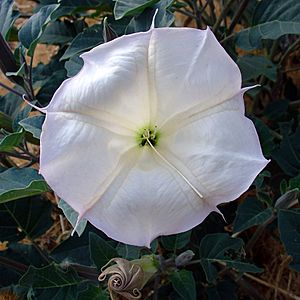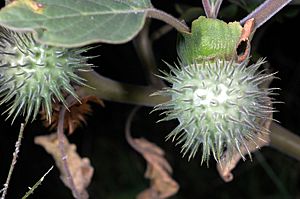Sacred datura facts for kids
Quick facts for kids Sacred datura |
|
|---|---|
 |
|
| Sacred datura in bloom | |
| Scientific classification | |
| Genus: |
Datura
|
| Species: |
wrightii
|
Datura wrightii, commonly known as sacred datura, is a poisonous perennial plant species and ornamental flower of the family Solanaceae native to the Southwestern United States and northwestern Mexico.
Contents
Taxonomy
German botanist Eduard August von Regel described the species in 1859 from material collected in Texas by botanist Charles Wright, and named it after him. The correct spelling since is with one "i", per ICN article 60C.2.
The scientific name has frequently been given as Datura meteloides Dunal, but this name is actually a synonym of D. innoxia Mill., a Mexican plant with a narrower flower having 10 rather than five "teeth" at the rim.
Common names in the US include "sacred thorn-apple" or "hairy thornapple", and sometimes "western Jimson weed" because of its resemblance to Datura stramonium. Anglophone settlers in California often called it "Indian whiskey" because of its ritual intoxicating use by many tribes; the name "sacred datura" has the same origin. Other common names include "Indian apple", "California jimson weed" and "nightshade" (not to be confused with Solanum). The Tongva call it manit and the Chumash momoy. Mexicans call this and similar species tolguacha. or toloache.
Description
It is a vigorous herbaceous perennial that grows 30 cm to 1.5 m tall and wide. The leaves are broad and rounded at the base, tapering to a point, often with wavy margins. The flowers are the most striking feature, being sweetly fragrant white trumpets up to 20 cm (7.9 in) long, sometimes tinted purple, especially at the margin. Five narrow points are spaced symmetrically around the rim. The plants often can be seen as a ground vine in habit, growing close to the ground and spreading in a very exposed environment with full direct sunlight (cleared roadside). D. Wrightii, blooms from April through October. In clear weather, flowers open in the morning and evening and close during the heat of the day (depending on water availability); in cloudy weather, they may open earlier and last longer.
The seeds are borne in a spiny, globular capsule 3 to 4 cm in diameter, which opens when fully ripe.
Distribution and habitat
Datura wrightii is found in northern Mexico and the adjoining southwestern U. S. states, as far north as southern Utah, in open / disturbed land and along roadsides with well-drained (sandy) soils. However it is perhaps most naturally abundant in the region of Southern California. It is also commonly planted as an ornamental, especially in xeriscapes due to its ruderal characteristics.
Invasive status
In Australia, it has been recorded as a garden escapee in New South Wales, Victoria, South Australia and Western Australia.
Toxicity
All parts of Datura plants contain dangerous levels of poisonous chemicals and may be fatal if ingested by humans, livestock, or pets. In some places, it is prohibited to buy, sell or cultivate Datura plants. Unlike other types of datura, the roots are considered the most potent and alkaloid-rich part of this species.
Uses
Medicinal
Among the Zuni people, the powdered root is given as an anesthetic for surgery. They also apply a poultice of root and flower meal applied to wounds to promote healing.
Religious
Southern California has been the site of various toloache (datura) based religions. Datura wrightii is sacred to some Native Americans and has been used in ceremonies and rites of passage by Chumash, Tongva, and others. Among the Chumash, when a boy was 8 years old, his mother gave him a preparation of momoy to drink. This was supposed to be a spiritual challenge to the boy to help him develop the spiritual well being required to become a man. Not all of the boys survived. The Zuni people also use the plant for ceremonial, magical, and divinatory purposes. The root pieces are chewed by a robbery victim to determine the identity of the thief. The powdered root is also used by rain priests in a number of ways to ensure fruitful rains.
Images for kids
-
Unfolding Sacred Datura buds painted on a Hohokam Sacaton red-on-buff plate, ca. 950-1150 AD. This was a common decorative motif on ancient Native American pottery. Note the opening spiral of the bud on the photo at top of this page.




